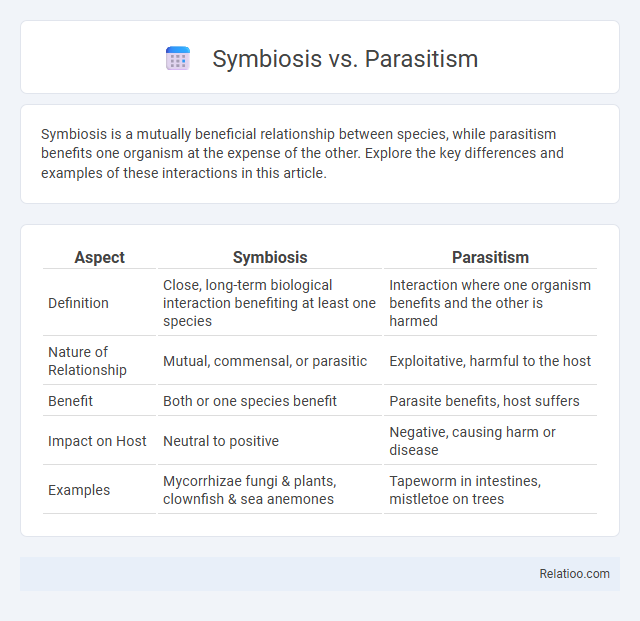Symbiosis is a mutually beneficial relationship between species, while parasitism benefits one organism at the expense of the other. Explore the key differences and examples of these interactions in this article.
Table of Comparison
| Aspect | Symbiosis | Parasitism |
|---|---|---|
| Definition | Close, long-term biological interaction benefiting at least one species | Interaction where one organism benefits and the other is harmed |
| Nature of Relationship | Mutual, commensal, or parasitic | Exploitative, harmful to the host |
| Benefit | Both or one species benefit | Parasite benefits, host suffers |
| Impact on Host | Neutral to positive | Negative, causing harm or disease |
| Examples | Mycorrhizae fungi & plants, clownfish & sea anemones | Tapeworm in intestines, mistletoe on trees |
Understanding Symbiosis and Parasitism
Symbiosis encompasses various types of close biological interactions, including mutualism, commensalism, and parasitism, where both species generally benefit, one benefits without harm, or one benefits at the expense of the other, respectively. Parasitism specifically describes a relationship in which one organism, the parasite, gains resources or shelter while causing harm to the host organism. Understanding these interactions is crucial for studying ecological balance, species evolution, and ecosystem dynamics.
Key Differences Between Symbiosis and Parasitism
Symbiosis encompasses diverse biological interactions where two species live closely, including mutualism, commensalism, and parasitism, with mutual benefits or neutral effects for at least one organism. Parasitism specifically denotes a symbiotic relationship where one organism, the parasite, benefits at the expense of the host, often causing harm. The key difference lies in parasitism's exploitative nature versus other forms of symbiosis that may involve mutual benefits or no harm to the host.
Types of Symbiotic Relationships
Symbiotic relationships encompass mutualism, commensalism, and parasitism, each differing in the benefits and harms to the organisms involved. Mutualism benefits both species, commensalism benefits one without affecting the other, while parasitism benefits one at the expense of the other. Understanding these types helps you recognize how organisms interact and survive in ecosystems.
Forms of Parasitic Interactions
Parasitic interactions manifest in various forms including ectoparasitism, where parasites live on the host's surface, and endoparasitism, where they reside inside host tissues or organs. You should recognize that parasitism involves one organism benefiting at the expense of the host, often causing harm, distinguishing it from mutualistic symbiosis where both partners benefit. Understanding these parasitic forms highlights crucial ecological dynamics and their impact on host populations in comparison to neutral or beneficial symbiotic relationships.
Mutualism: A Win-Win Symbiosis
Mutualism represents a win-win symbiosis where both species derive benefits essential for survival, growth, or reproduction, distinguishing it from parasitism where one benefits and the other is harmed. Classic examples include pollinators like bees and flowering plants, and nitrogen-fixing bacteria in legume root nodules, showcasing mutual nutrient exchange and protection. This mutualistic relationship enhances ecosystem balance by promoting biodiversity, resource sharing, and evolutionary advantages for the involved organisms.
Impact of Parasitism on Host Organisms
Parasitism profoundly affects host organisms by draining nutrients, weakening immune defenses, and causing tissue damage, which can lead to reduced growth, impaired reproduction, and increased susceptibility to diseases. Unlike mutualistic symbiosis, where both organisms benefit, parasitism benefits the parasite at the host's expense, often resulting in significant physiological stress and population-level impacts. Understanding parasitic dynamics is crucial for managing ecosystems and controlling diseases in wildlife and agriculture.
Examples of Symbiosis in Nature
Examples of symbiosis in nature showcase mutualistic relationships where both species benefit, such as the clownfish and sea anemone, where the clownfish gains protection and the anemone receives cleaning services. In contrast, parasitism involves one organism benefiting at the expense of another, like ticks feeding on mammals, harming their hosts. Commensalism represents a neutral relationship where one species benefits without impacting the other, exemplified by barnacles attaching to whales for transportation without affecting the whale.
Notable Parasitic Relationships in Wildlife
Notable parasitic relationships in wildlife include the interaction between cuckoos and their host birds, where cuckoo chicks are raised at the expense of the host's offspring. Another example is the relationship between ticks and mammals, where ticks attach to their hosts to consume blood, often transmitting diseases. These parasitic interactions contrast with mutualistic symbiosis, where both species benefit, and commensalism, in which one species benefits without affecting the other.
Evolutionary Significance of Symbiosis and Parasitism
Symbiosis and parasitism represent distinct evolutionary strategies influencing species adaptation and survival, where symbiosis fosters mutual benefits enhancing co-evolutionary relationships, while parasitism drives host-pathogen arms races promoting genetic diversification. The evolutionary significance of symbiosis lies in its ability to create complex biological systems and new ecological niches through mutualistic interactions, as evidenced in lichens and gut microbiota. Parasitism, by imposing selective pressures on hosts, accelerates evolutionary innovation and immune system complexity, shaping species fitness and ecosystem dynamics.
Ecological Implications of Symbiosis vs Parasitism
Symbiosis encompasses various close biological interactions, including mutualism, where both species benefit, contrasting with parasitism, where one organism benefits at the expense of the other. Ecological implications of symbiosis include enhanced biodiversity, improved nutrient cycling, and ecosystem stability through cooperative relationships. Parasitism, however, can regulate host population dynamics and drive evolutionary adaptations but may reduce host fitness and biodiversity if parasitic pressures become too intense.

Infographic: Symbiosis vs Parasitism
 relatioo.com
relatioo.com